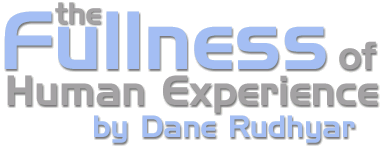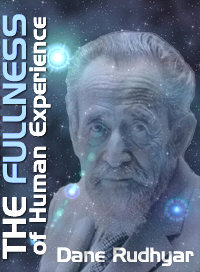 |
| Home | Bio | Art | Music | Literature | Civilization & Culture | Philosophy of Wholeness | Theosophy & Spirituality | Astrology |

CHAPTER SEVEN
A New Frame of Reference: The Earth-being & the Function of Humanity within It - 2 A: Biocultural frames of reference The development of a new type of organism — homo sapiens — in which new desires and a new mind were slowly taking form started from the strictly biological foundation of instinctual responses to vitalistic needs. The satisfaction of these needs was the one fundamental concern of whatever type of group-organization human beings established. As the specifically human capacity to communicate and to transmit the results of biological experiences to successive generations came to take enduring forms, these forms became the foundation of a particular culture. It was a particular type of foundation utterly conditioned by the character of the collective experiences the early tribesmen had in a strictly local ecosystem. These experiences were related to the seasonal processes of vegetation and the actions of animals capable not only of aggression but also of providing the food needed for survival. A culture establishes a frame of reference for the experiences of a group of people intent on developing a more secure and pleasant way of surviving in an often inimical environment. This frame of reference enables the members of the culture to deal in as satisfying a way as possible with a more or less expectable series of recurrent changes and external events, the possibility being related to and limited by the "human condition" as this condition is experienced and understood at any particular level of human evolution. Whenever this evolution occurred from an animal state without any helpful and instructive contact with the remnants of a slowly-disappearing earlier and fully developed humanity, the earliest cultural frame of reference to be established by a human tribe constituted the attempt to define some kind of stable and effective relations, not only with animals and plants, but with rather mysterious transcendent entities assumed — and in some cases, actually perceived — to be responsible for either helpful or disastrous environmental changes. Such a frame of reference has been referred to as animism. Animism is a system of organization enabling a community of human beings to meet in a relatively effective manner with daily and yearly recurring events identified as the actions of recognizable entities to which names could be given. A human person is also an entity having a definable character and a particular amount of usable energy. This energy is basically biological but when belonging to a well-developed culture, a person is able to control events and processes of change through the development of the technical mind. At the animistic stage of mental understanding, and in terms of the knowledge which animistic cults and ways of life transmit and gradually make more effective, control operates on the basis of force against force. A biologically inferior force, however, may develop mental strategies (such as cunning, deception, sacrifice, and prayer) which can be expected to produce tangible results in relation to a superior force, especially if the latter is assumed to have an inherently beneficent character or to gain some kind of advantage from the operation. In the terminology of modern philosophy — particularly the philosophy of science — atomism is taking the place of animism. The vibratory types of energy to which material atoms and particles have been reduced are not essentially different from the "spirits" with which shamans and ancient seers have dealt However, while the concepts and practices of primitive animism had a strictly biological and ecological basis, modern scientific atomism assumes the objective existence of a non-living substratum called "matter." As we shall presently see, the possibility of measuring and dividing this matter leads to the development of a new and radically different frame of reference. Spirits are identifiable entities to the extent that they act in a characteristic manner. A great multiplicity of spirits were believed to act in the life-environment of human beings, each spirit producing experienceable changes according to its specific quality and the form it would take while releasing its energy. However, when the approach to the collective experience of human beings took the form often known as vitalism, a new type of relationship to the environment (and by extension to an imagined, all-inclusive environment, the universe) developed in a variety of ways. Vitalistic cults gave a ritualized form to human experience when agriculture and cattle-raising came to provide a stable and effective structure for communal survival and expansion. The new vitalistic frame of reference was no longer essentially based on the conflicts between spirits, and in general between warring entities involved in force-against-force situations; it referred to the cyclic interaction of two universally present modes of operation — two polarities of a single, all-inclusive "reality" always in motion. This motion, however, was understood to be inherently equilibrated and harmonic; and the purpose of a culture was to establish in a community of human beings a similar type of harmony and balance of power in terms of interpersonal relatedness and fully organized functional coactivity. This did not mean that all conflicts between spirits, or between the still force-determined, aggressive, and ambitious elements in a community, could be resolved. But vitalistic cults sought to offer means of adjustment in terms of the frame of reference provided by the cyclic and balanced operation of the "One Life" manifesting in the interaction of two great tides of sexual energies. Biological activity and life's command to "increase and multiply" had been developed in the prehuman, vegetable, and animal phases belonging to the involutionary arc of the great cycle, long before the great reversal of the Noon point. Thus, I refer not to this but to the evolutionary development of homo sapiens and of levels of culture, each of which provides a basic frame of reference for the operations of societies in terms of a fundamental principle of organization. When the ideal of personhood became incorporated in the vitalistic frame of reference, the concept of autonomous entities responsible for individually definable activities acquired a new meaning. In the new picture, "spirits" were replaced by "individual Souls," and the One Life was replaced by the one and only God who created them. Having become "great religions," the ancient cults were deeply concerned with these Souls which somehow had become attached to human bodies. As a result the human body acquired a fundamental importance. Yet vitalistic cultures gave hardly any value to what happened to individual bodies. The biological species mattered, not any one of its specimens. The quality of Life was what counted, not the amount of happiness or degree of well-being of any living organism. The latter always was considered expendable. By permission of Leyla Rudhyar Hill Copyright © 1986 by Leyla Rudhyar Hill All Rights Reserved.  Web design and all data, text and graphics appearing on this site are protected by US and International Copyright and are not to be reproduced, distributed, circulated, offered for sale, or given away, in any form, by any means, electronic or conventional. See Notices for full copyright statement and conditions of use. Web design copyright © 2000-2004 by Michael R. Meyer. All Rights Reserved. |
 |
